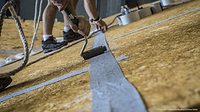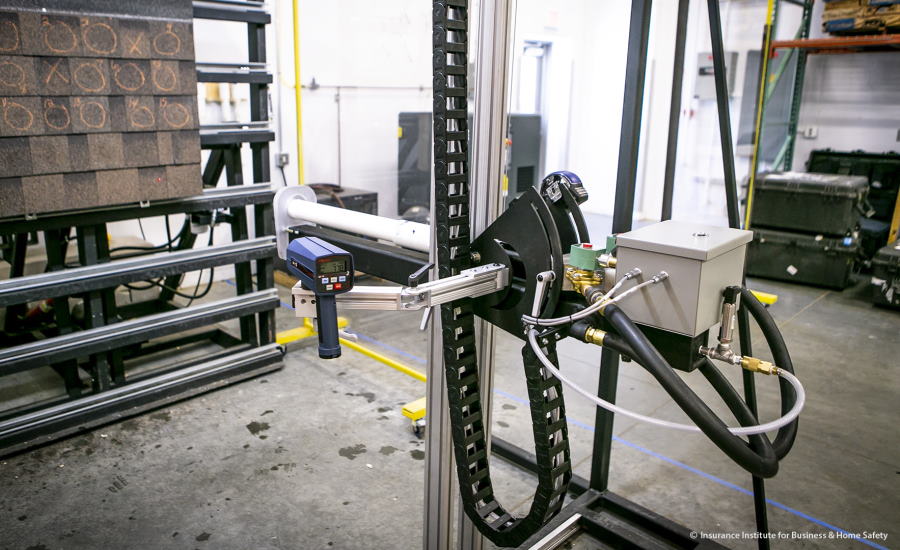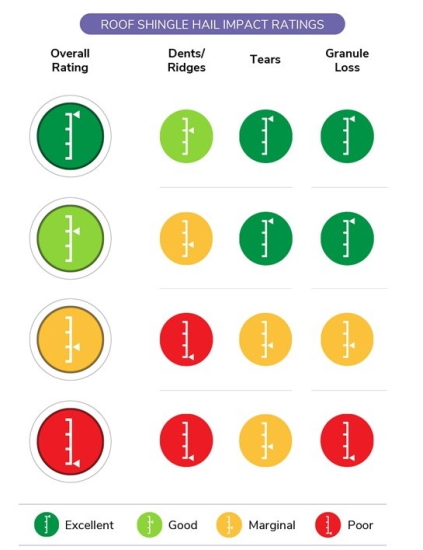IBHS Launches FORTIFIED HOME Hail Standards and Virtual Training
Hail Standards Based on New Research Involving 'Hard' and 'Soft' Hail Damage

IBHS creates hailstones in its lab and launches them at shingles using air cannons to accurately gauge how shingles stand up to the impacts. Photos courtesy of IBHS.
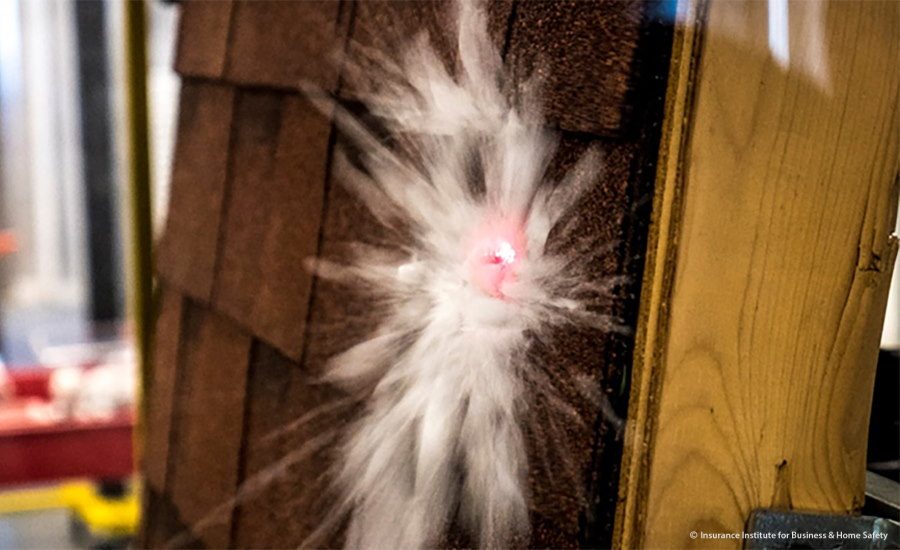
The moment a hailstone impacts against a shingle in the IBHS testing facility.
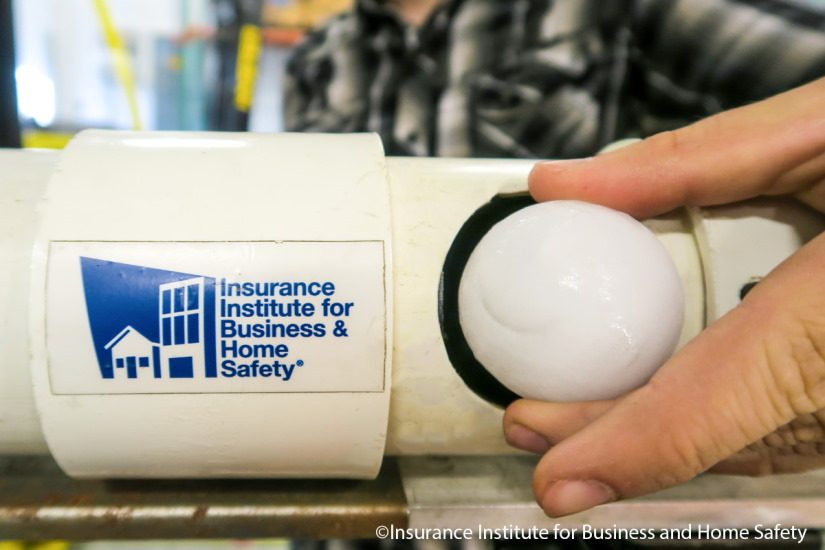
After creating hailstones in the lab, researchers prepare to use them in air cannons to simulate the speed at which real hail strikes a roof.

The ratings system IBHS uses when ranking shingles for their impact resistance.

IBHS researchers mark the damage on shingles to determine just how well they stand up to hailstones. Photo: IBHS.





Meteorologists predict the 2020 storm season to be more active and extreme than previous years, so homeowners will be looking to roofing contractors to create solid roofs that protect them from the elements.
Whether those elements are hurricane-force winds or giant hailstones, the nonprofit Insurance Institute for Business & Home Safety (IBHS) is now offering contractors new above-code design, building and retrofitting steps and the virtual training to create FORTIFIED roofs and homes.
After nearly a decade of research, IBHS has unveiled a hail upgrade to its FORTIFIED HOME™ – High Wind standard to give homeowners and contractors the option to further strengthen homes against severe weather. Known as FORTIFIED HOME – High Wind & Hail, the program goes beyond code design to create roofs that can withstand EF-2 level winds and 2-inch hail.
The High Wind & Hail standard is based on cutting-edge studies conducted at the IBHS’ research center in Richburg, S.C. Along with recreating storm conditions like 130 mph winds, the lab has found a way to faithfully recreate hail conditions found in nature in order to test the damage they cause to residential properties. The system is being piloted in Oklahoma City alongside the Oklahoma-based Disaster Resilience Network.
“Now that we have our own test method that better represents real-world damage, we are now requiring, in order to receive the FORTIFIED designation, that you use a shingle that is ‘good’ or ‘excellent’ rated on our performance scale,” Dr. Tanya Brown-Giammanco, managing director of research at IBHS.
Traditionally, testing shingles for their resistance to hail damage involved UL 2218 tests, which consists of dropping steel balls onto them. But the researchers at IBHS knew this wasn’t how Mother Nature really operates. Starting in 2012, they collected roughly 3,000 different hail samples from around the country to study.
“It’s the largest research catalog on hailstones in the country and probably the world,” said Brown-Giammanco. “It took a lot of time. We would usually be excited if we could get a sample of 100 stones in an individual storm.”
In studying them, they realized creating hail from pure water resulted in ice balls with too much mass and density to be used in testing. Researchers experimented with mixing in different types of water, from tap to seltzer, to control the density. Once they perfected their formula, they devised a way to automate the creation of 1,000 hailstones a day, a far cry from their previous limit of making 150 a day by hand.
“Ice is one of the hardest materials to work with,” Brown-Giammanco said. “Once it gets out of the freezer, you just don’t have a lot of time to work with it.”
Testing Roofing Components
With the hail component solved, it was then a matter of determining how to properly test roofing materials. IBHS selects the products to test and rates them according to their abilities to withstand severe weather or help create a roofing system that meets it standards, which requires:
- Stronger connections to hold the roof on the house
- Reinforced edges to help protect one of the roof’s most vulnerable areas
- A sealed roof deck to prevent rain from entering a home even if shingles are lost
- High-performing, impact-resistant shingles that are superior performers
“Not all shingles labeled as ‘impact-resistant’ perform equally,” Brown-Giammanco said. “Existing standardized tests use outdated physics and are unable to replicate all the different kinds of damage we see on roofs.”
After reviewing asphalt shingle product literature, IBHS selects and purchases widely-sold and widely-marketed products as opposed to receiving them directly from a manufacturer’s factory. This further helps mimic what actual homes will experience.
For the hail test, IBHS researchers load their homemade hail into CO2-powered guns to fire at shingles to simulate the speed in which they strike a roof. What they found was that their hypothesis about hard and soft ice was founded, as each causes different damage — hard ice damage causes dents and cracks, while soft ice damage knocks off more granules and exposes the asphalt underneath.
In testing shingles with Class 3 or 4 impact ratings, IBHS’ findings revealed that shingles made with polymer modified technology withstand hail damage better than traditional, oxidized shingles with scrim on the back.
“It was nice to see that pattern confirmed, but also gives us a glimpse of the way the industry is trending too,” Brown-Giammanco said.
Along with the hail resistance, the FORTIFIED standard is an effective option to combat winds up to EF-2 levels. Brown-Giammanco, who is also a wind engineer and meteorologist, said it’s important to note tornadoes rated as EF-4 or EF-5 have very small areas where the winds are that strong.
"FORTIFIED can narrow the path of damage so building to this standard has the potential to bring peace of mind to homeowners routinely threatened by tornadoes and high winds," she said.
IBHS FORTIFIED Home Virtual Training
Roofing contractors interested in adding IBHS FORTIFIED standards to their repertoire typically had to take a four-hour course in person. With the COVID-19 pandemic limiting such in-person events, IBHS is preparing to make its training available in a virtual setting as well.
“We’re really about making the training accessible so that folks can be out there building trust and showing their expertise in how they can help homeowners live in safe and stronger homes,” said Fred Malik, managing director of FORTIFIED Building Products.
Virtual training will be available to contractors in mid-June, with multimedia modules that are no longer than 20 minutes each. The training offers two avenues to explore: The first is to educate contractors on the different ways of executing IBHS’ standards, while the second allows contractors to list themselves in IBHS’ directory upon completing an exam.
“It’s a way to distinguish yourself as a roofer amongst your peers and saying ‘I’ve kept on the cutting edge, I have become aware of this FORTIFIED program, it’s based in decades of science, and as a result, I have the ability to offer this to you,’” Malik said.
Homeowners benefit beyond having a stronger home. Homeowners in certain states can receive an insurance discount once their homes receive a certificate from IBHS, and the designation serves as a nice incentive when selling a property. Homeowners can also rest assured that their roof is not only built by trained roofing contractors, but is inspected independently to ensure it’s up to FORTIFIED standards.
To receive a FORTIFIED designation, homeowners must have their roofer, or a FORTIFIED evaluator, submit required documentation confirming the requirements have been met to IBHS.
“Because it’s somebody volunteering to participate and offer it, they are also voluntarily asking a third party to come out and confirm that the roof does in fact meet these additional standards,” he said. “Each FORTIFIED roofer works with an evaluator in their market to be able to verify the way the roof was assembled…the evaluators partner up with roofers so as not to delay the schedule.”
While some areas, such as Oklahoma, Alabama or coastal cities have higher concentrations of FORTIFIED homes and contractors, Malik noted it is worth it for contractors around the country to look into becoming trained in these standards.
“They’re able to use some of our collateral so that they can include that in their sales brochures and help them win at the kitchen table,” Malik said.
Looking for a reprint of this article?
From high-res PDFs to custom plaques, order your copy today!





